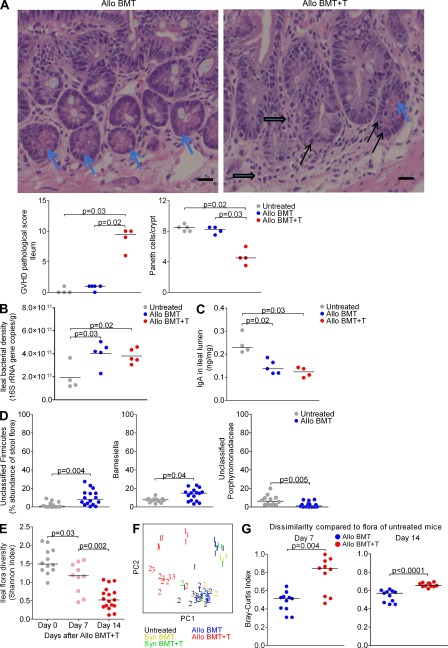Figure 1.
GVHD in mice produces marked changes in the microbiota. (A) B6 mice were lethally irradiated and transplanted with 5 × 106 B10.BR T cell–depleted BM supplemented with or without 1 × 106 splenic T cells. Features of GVHD are indicated on ileal histology sections from day 14, including lymphocytic infiltration (block arrows), crypt regeneration (enlarged crypts and hyperchromasia), and apoptosis (black arrows). Paneth cells are indicated (blue arrows). Bar, 20 µm. Representative images are shown from one of two independent experiments with similar results. Each dot represents an individual mouse, with bars indicating medians. (B) Quantitation of bacterial load of ileal contents on day 14 was performed by quantitative PCR of 16S rRNA gene copies. Results of a single experiment are shown. (C) Quantification of IgA levels in ileal contents on day 14 was performed by ELISA. Results of a single experiment are shown. (D) Comparison of representation by Unclassified Firmicutes, Barnesiella, and unclassified Porphyromonadaceae from ileal samples. Combined results from three experiments are shown. (E) Diversity of ileal floras from mice with GVHD was determined by the Shannon index. Combined results from two experiments are shown. (F) Principal coordinate analysis of unweighted UniFrac, of ileal floras from B6 mice transplanted with syngeneic (syn) or allogenic (allo) BM with or without T cells. Combined results from three experiments, with data points from each experiment indicated by number. Mice from experiment three were housed individually. (G) Dissimilarity of ileal floras of allo BMT recipient mice without and with GVHD compared with untreated mice by Bray-Curtis index. Combined results of two (Day 7) and 3 (Day 14) experiments are shown.

